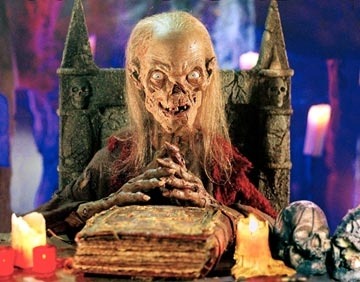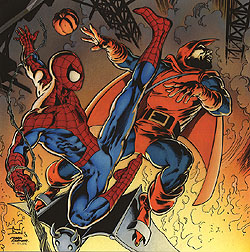Despite all my years as a huge horror film buff, I somehow never got around to seeing Tales from the Crypt, the iconic HBO anthology starring an animatronic corpse who cracks himself up with his own ridiculous puns. My sudden interest in checking it out came after I read a fantastic book about the legendary 1950s horror comics called "The Horror! The Horror! Comic Books the Government Didn't Want You to Read!" That title is anything but hyperbole, by the way, but we'll get to that in a minute.
I knew a bit about the 1950s horror comics beforehand - I had seen some of them and had been impressed by how frighteningly brilliant they still are. The book made a compelling case that society needed this kind of grim entertainment to process the horrors of World War II, something not allowed by the stifling entertainment that typically defines this decade. The surrealistic gore and dark twist endings weren't all they had to offer, either. Many took on issues of the day, including racial discrimination in an era when it was not politically correct to do so. The comics were hugely popular and eventually attracted the attention of the usual suspects who can be counted on to spoil the fun for the general public. Since video games wouldn't be invented for a long time, the so-called "moral guardians" decided that horror comics were single-handedly turning children into murderous delinquents and the issue even led to Congressional hearings.
Eventually, the criticism became so intense that the comics industry adopted a system of self-censorship. Every issue could be evaluated and if deemed acceptable, would receive approval from the Comics Code Authority. When it first began, the rules were so strict that you couldn't even have the word "horror" on the cover. Of course, you didn't have to get the seal but most retailers were unwilling to put comics on the shelves unless approved. It's a bit like how the MPAA can use the NC-17 rating to banish independent films from the majority of movie theaters if there's too much gay sex in them. This ultimately destroyed the horror comics...they were gone, but definitely not forgotten.
By the time Tales From the Crypt, which adapts a comic for each episode, premiered in 1989, everything had changed. The groundbreaking intensity of 1970s horror films, followed by the gore-crazy 1980s, had demolished many of the taboos of the past. The comics were reborn with all the violence, swearing and nudity that's still a hallmark of HBO, but instead of being ostracized it was welcomed with open arms and lasted for seven seasons. Major movie stars and directors couldn't join in the fun fast enough. The Cryptkeeper began showing his ugly face all over the place, including a few movie spin-offs and a Saturday morning cartoon version where he introduced stories that actually had happy endings. A more detailed look at the story of those comics can be found in a fantastic hour-long documentary on the Season 1 DVD. But let's talk about the episodes! I gave up using letter grades for reviews a while ago, but I'm going to bring it back for now just because there's so many episodes to discuss and it could get hard to make comparisons eventually.
The Man Who Was Death: The pilot was directed by Walter Hill, the distinctive filmmaker behind cult classics like The Warriors and Streets of Fire. His sensibility meshes well with the story of Niles Talbot (Bill Sadler), an executioner who enjoys throwing the switch far too much. When his state unexpectedly abolishes the death penalty, he finds himself out of a job and decides to hunt down and electrocute acquitted murder suspects in his spare time. It’s fairly predictable, especially the final twist, but the story really couldn’t end any other way. Sadler is entertaining in the lead role and there’s a nice satirical point here – Talbot is just doing his job when pulling the switch on behalf of the state, but killing people in the exact same fashion outside of work makes him an outlaw. A-
And All Through the House: Directed by Robert Zemeckis (Who Framed Roger Rabbit?), this is a morbidly funny tale of a scheming wife (Mary Ellen Trainor) who murders her husband on Christmas Eve and plans to indulge in his money with her new boyfriend, who inexplicably refers to himself as “The Dick Monster.” She gets her comeuppance when the house is invaded by an axe-murdering lunatic dressed as Santa (character actor Larry Drake). Zemeckis stages the mayhem very well and the ending evokes classic horror films by not showing the money shot and leaving it to your imagination, where it’s sure to be much more gruesome. It’s ridiculous, but that comes with the territory when you’re dealing with evil Santas. One thing’s for sure, it’s a lot better than Silent Night, Deadly Night. B
Dig That Cat…He’s Real Gone: The first great episode comes courtesy of Lethal Weapon director Richard Donner, who employs a lot of flashy editing tricks reminiscent of comic book panels. A homeless man (Joe Pantoliano) undergoes a mad scientist’s experiment to give him a cat’s nine lives and becomes a sideshow sensation as “Ulrich the Undying.” It’s a hilarious episode with great twists and a dim view of human nature that’s consistent with the comics that inspired this series. As a bonus, there’s also an incisive NRA joke that’s even more satisfying now than it was in the late 1980s. A
Only Sin Deep: A weak episode about a vain prostitute (Lea Thompson) who sells her beauty to the local pawn shop owner/sorcerer for a small fortune. After she uses the money to insinuate herself into the 1 percent, she suddenly begins to age rapidly. It’s meant to be an indictment of the character’s greed, but the details of the deal sound so harmless (he only asks to make a plaster mold of her face) that even the most virtuous person would have agreed. It’s a lot more interesting when someone makes a devil’s bargain knowing full well what they are getting into, with Ariel in The Little Mermaid as just one example. Aside from that, the episode also suffers from clumsy dialogue, a weak ending and Thompson’s obnoxious New York accent. C-
Lover, Come Hack to Me: This ridiculously sleazy episode makes me glad I never watched this show growing up with my parents in the room. Directed by Tom Holland (Child’s Play), it’s the story of a sad little heiress (Amanda Plummer) and her obnoxious gold-digging spouse (Stephen Shellen, a rare male example of this trope) who get lost in a storm on their wedding night and find shelter in a creepy abandoned mansion. While there, he finds out more than money runs in her family. The ending is satisfyingly gruesome, but the rest of the episode drags like crazy. It illustrates the potential problems of adapting those 50s comics – many of the stories were only about 4 or 5 pages, which means you’ve got to be creative while stretching them to a half-hour of television. Didn’t work so well here. C+
Collection Completed: The golden years aren’t so great for a retired workaholic (M. Emmet Walsh) and his crazy-cat-lady wife (Audra Lindley). Slowly driven insane by a series of petty domestic slights, he adopts a twisted new hobby. Walsh is great as the miserable old bastard and director Mary Lambert (Pet Sematary) captures the necessary buildup that was missing from the previous episode. It’s a great example of the pitch black humor that seems to be an early strength of the series. A
Only six episodes for Season 1...they were just testing the waters. There are a lot more in Season 2, so we'll see if things become more consistent. Then again, anthologies in general tend to be pretty hit and miss. If I don't get another one of these up before then, Happy Halloween!
Subscribe to:
Post Comments (Atom)






No comments:
Post a Comment